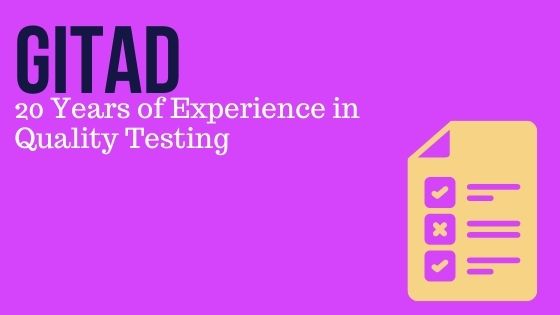In his presentation during the GCLAITH meeting during ISHI 31, Prof. Dr. Juan Carlos Alvarez (Laboratorio de Identificación Genética – Universidad de Granada) discussed the 20 years of accumulated experience that the interlaboratory exercise carried out by the Ibero-American Group of Work in DNA Analysis (GITAD) in most of the Latin American countries, Spain, and Asia.
This working group and the quality control are internationally recognized and the certificates that are issued help to validate the competence of some laboratories, for example, to introduce genetic profiles in different genetic databases.
He presented the main problems encountered in the tour through the GITAD quality control experience, and their possible resolution due to the help provided by the annual discussion of the control results. As there was not time for him to answer all the questions that came in during the conference, we’ve compiled those that weren’t answered below.
Are tests sent for each analyst in the laboratory? Or just one test for the whole lab?
The samples are sent to each laboratory. This is due to the significant increase in the number of participating laboratories. Exceptionally, an additional sample has been sent, especially in laboratories with a very large number of analysts.
We participated in the 2019 test, and sent it in January 2020, but we still have not received results.
Our intention was to hold our annual GITAD meeting in May, in the city of Granada (Spain), but the events with COVID made it impossible, so we have moved the meeting to the month of November online and there the results will be discussed for subsequently send the certificates of participation.
What are the advantages of the UDS tests compared to those of the CTS (collaborative testing service) and GHEP?
Anything that means having alternatives and options in external quality controls is always welcome, whether it requires accreditation of the exercise and it becomes an aptitude test, or if they want to be used as additional controls, in this case also free for participants.
Where do the bone remains from the GITAD quality tests come from?
The skeletal remains were a type of sample that we sent at the beginning of the exercises, the first years in which the number of participants was also lower. We have no longer used this type of matrix due to various circumstances, such as the large number of participants and the additional problems it could cause with the submissions.
En la charla propuesta, que podría encuadrarse dentro del bloque temático de Calidad en Laboratorios de Genética Forense, se expondrá a los participantes del Grupo Científico Latinoamericano de Trabajo sobre Identificación Humana, los 20 años de experiencia acumulada en el ejercicio interlaboratorio que el Grupo Iberoamericano de Trabajo en Análisis de DNA (GITAD) lleva a cabo en gran parte de los países de Latinoamérica, España (y también Asia).
Este grupo de trabajo y el control de calidad son reconocidos internacionalmente y los certificados que se emiten ayudan a validar la competencia de algunos laboratorios, para por ejemplo, introducir perfiles genéticos en distintas bases de datos genéticas.
En el recorrido por la experiencia del control de calidad de GITAD se expondrán las principales problemáticas encontradas y su posible resolución gracias a la ayuda que ha supuesto la discusión anual de los resultados del control. Asimismo, se dará a conocer a otras personas y laboratorios del ámbito latinoamericano que asistan a la reunión, la gratuidad del mismo y que está abierto a la participación de todos aquellas personas que quieran llevarlo a cabo.
Se envían pruebas para cada analista en el laboratorio? O solamente una prueba para todo el laboratorio?
Las muestras se envían a cada laboratorio, esto debido al aumento importante en el número de laboratorios participantes. Excepcionalmente se ha enviado alguna muestra adicional sobre todo en laboratorios con un número de analistas muy importante.
Nosotros participamos en la prueba 2019, la enviamos en enero 2020, pero aun seguimos sin recibir resultados
Nuestra intención era realizar nuestra reunión anual de GITAD en Mayo, en la ciudad de Granada (España) pero los acontecimientos con el COVID lo imposibilitaron, por lo que hemos trasladado al mes de Noviembre la reunión de modo telemático y ahí se discutirán los resultados para posteriormente enviar los certificados de participación.
Que Plus tienen las pruebas de uds en comparacion con las del CTS (collaborative testing service) y GHEP?
Todo lo que sea tener alternativas y opciones en controles de calidad externos siempre es bienvenido, tanto si se requiere acreditación del ejercicio y se convierta en un ensayo de aptitud, como si se quieren utilizar como controles adicionales, en este caso además gratuitos para los participantes.
De donde provienen los Restos óseos de las pruebas de calidad GITAD?
Los restos óseos fueron un tipo de muestra que enviamos al inicio de los ejercicios, los primeros años en los que además el número de participantes era menor. Ya no hemos vuelto a utilizar este tipo de matriz por varias circunstancias, como el gran número de participantes y los problemas adicionales que podrían suscitar con los envíos.
WOULD YOU LIKE TO SEE MORE ARTICLES LIKE THIS? SUBSCRIBE TO THE ISHI BLOG BELOW!
SUBSCRIBE NOW!


